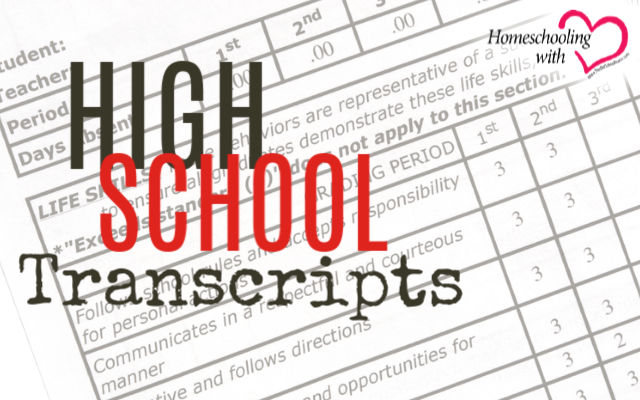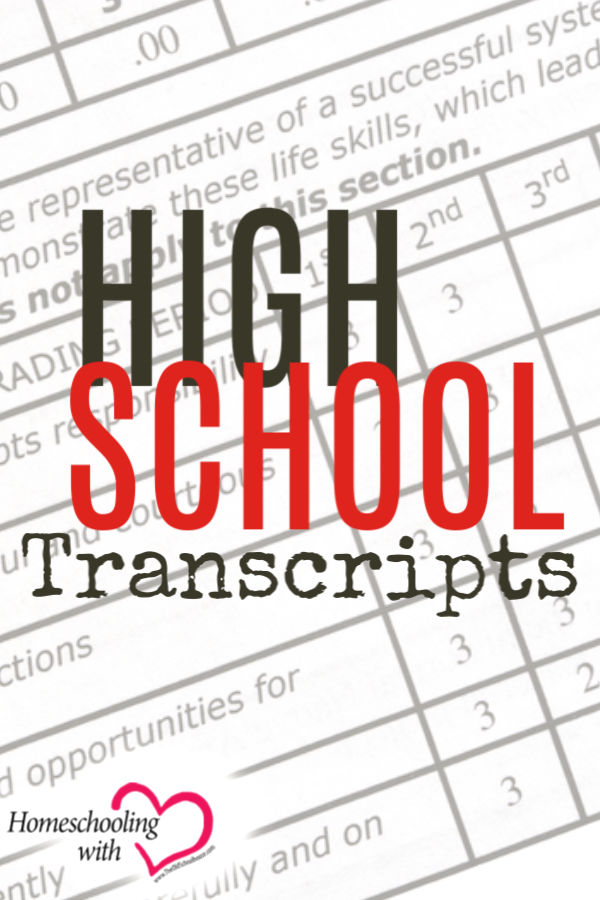High School Transcripts


DON’T even think about not providing your children with high school transcripts! No matter where a student is educated—public school, private school, or homeschool—that student deserves a transcript from the people who organized the academic program, taught the courses, and evaluated the work. If you want to teach high schoolers at home, you absolutely must provide them with the documentation of a transcript.
DO grant your children a high school diploma. High school graduation is an important benchmark and transition point in a young person’s life, and it should be honored as such. Your children deserve the right to say “yes”on job applications that ask if they have a high school diploma!
DON’T use the GED to document high school graduation. You may find yourself in situations that require a GED test score for screening or admissions purposes (however unjustified by law), but that does not mean you have to document graduation by a method that often carries the stigma of a high school dropout.
DO identify each child thoroughly on his or her transcript. You will need to indicate full legal name, current address, gender, birth date, parent or legal guardian name(s), and a Social Security number (especially crucial if you are applying for any financial aid to go to college).
DON’T feel obligated to make your transcripts match the public school system in timeline, structure, sequence, curricular options, or anything else. Home education is a tutorial process; thus, it is important to focus on the needs, interests, talents, and gifts of each individual child. Most tutorial education procedures do not follow the typical school structure of living between classroom bells and being classified as freshman, sophomore, junior, or senior—let alone sitting in lecture sessions of designated length and completing routine “busywork”assignments.
DO limit yourself to two pages (or one sheet front and back) for your printed transcript. Transcripts (like resum s) are supposed to present a summary of achievement and/or experience—short enough for the reader to know at a glance who the student is and what he has done. In academic and most employment circles, anything more than two pages becomes a portfolio.
DON’T succumb to any pressure— real or imagined—to require a college preparatory course lineup in order to graduate your children from high school. You do not have to satisfy any college admissions requirements to earn a high school diploma (i.e., there is absolutely nothing wrong with a diploma focused on apprenticeship, the trades, the arts, or any other pursuit of knowledge and skills). However, it does make sense if your child is college-bound to work the college’s admissions requirements into the student’s high school preparation.
DO use your child’s transcripts as an annual report card. This is especially helpful when applying for good driver discounts on auto insurance and work permits when employers need them, or to accompany resum s or applications for volunteer and paid positions, etc.
DON’T skip physical education credits. Some colleges actually ask students to make up deficiencies in physical education when they enroll. Remember that physical education generally earns half the credit that would be earned for a comparable amount of academic work.
DO include Bible credits if yours is a Christian program. Even if a college tells you that it does not recognize “Bible”or “Religious Studies,”your transcript should not be crafted by what the college accepts or denies. The transcript is a report of the work your child has completed.
DON’T be rigid about counting hours when assigning Carnegie Units. There is a great deal of variety in the computation of hours required to earn a Carnegie Unit of credit— requirements as low as 120 all the way to 250 hours! Since home education involves a tutorial process of teaching and learning, you will find many occasions when your child’s academic achievement is difficult to document in terms of a specific number of hours. Some situations work best with documentation by textbook equivalency, while others should have a diary of work experiences coupled with a bibliography for training. The important thing is that you know why you assigned a specific amount of credit to a course and that any variation from course to course reflects your stated objectives (and yes, for this you do need to do some planning!).
DO be consistent in your assignment of credits and grades—this is no place for emotional entanglement! Teachers do not give students grades. Students earn grades, and teachers simply record them accurately and honestly. Remember that consistency and equality are not synonyms—an A in math will be documented with different criteria than an A in Public Speaking, Home Economics, Orchestra, or World History. Planning your objectives for learning will help you make strategic assignments and identify the levels of achievement that deserve an A, B, C, and so on.
DON’T “weight”grades with extra GPA points unless you have the proper documentation for doing so. “Weighting”refers to a process of adding an extra grade point to a grade when the coursework is advanced (i.e., Advanced Placement or AP, college courses completed during the high school years, and Honors courses where you have a detailed syllabus that outlines the extra work requirements).
DO include the necessary statistical summaries: Grade Point Average (GPA) and a tally of the number of credits per subject area (e.g., Math, Foreign Language, English, Fine Arts, Social Sciences, Natural Sciences, Physical Education, etc.). While the most common GPA system involves a 4-point scale, there are at least four other possibilities for making this crucial college admissions calculation. Do a little research about what is common in your state, and then use the same system for the entire transcript. Remember that “class rank”should not be included—after all, your child is number one in a class of one!
DON’T forget standardized achievement test scores. DO report only the National Percentile Rank and Stanine (NPR/S), and avoid listing any grade equivalents. DO skip the subtest reports and work with the major sections of the assessment (i.e., Mathematics, Reading Comprehension or Language Arts, Basic Battery or Complete Battery).
DO include at least a summary of SAT and/or ACT scores—even though each college admissions officer will want a score report sent directly from the test provider.
DO figure out what addendum sheets should be attached to each program. Possibilities include Bibliography of Text Resources, Course Descriptions, Special Features of a Student’s Program, Method of Computing GPA, Guidance Counselor Recommendations, Work in Progress: Senior Year, Extracurricular Activity Descriptions, and so forth.
DON’T omit a specific high school graduation date—even if you have to list a projected date for juniors who submit early applications to colleges.
DO sign your child’s transcripts and provide a contact telephone number and/or e-mail address. While an embossed seal can add the “aura of officialness,” it is not required.










































